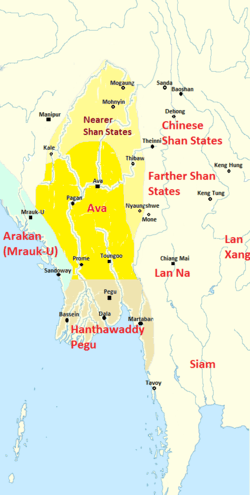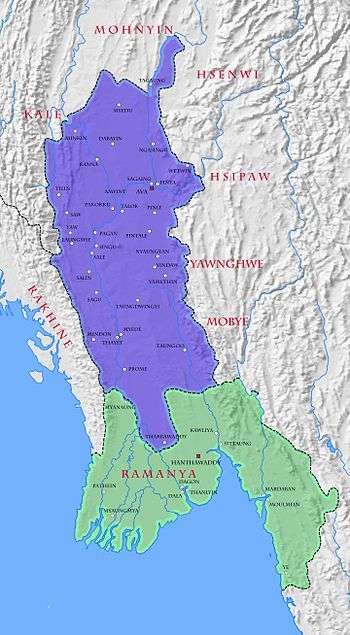Kingdom of Ava
The Ava Kingdom (Burmese: အင်းဝခေတ်, pronounced [ʔɪ́ɰ̃wa̰ kʰɪʔ]) was the dominant kingdom that ruled upper Burma (Myanmar) from 1364 to 1555. Founded in 1364, the kingdom was the successor state to the petty kingdoms of Myinsaing, Pinya and Sagaing that had ruled central Burma since the collapse of the Pagan Empire in the late 13th century.
Kingdom of Ava အင်းဝခေတ် | |||||||||||||
|---|---|---|---|---|---|---|---|---|---|---|---|---|---|
| 1364–1555 | |||||||||||||
 Ava c. 1450 | |||||||||||||
| Status | Kingdom | ||||||||||||
| Capital | Sagaing Pinya Ava | ||||||||||||
| Common languages | Old Burmese Old Shan | ||||||||||||
| Religion | Theravada Buddhism | ||||||||||||
| Government | Monarchy | ||||||||||||
• 1364–1367 | Thado Minbya | ||||||||||||
• 1367–1400 | Swa Saw Ke | ||||||||||||
• 1400–1421 | Minkhaung I | ||||||||||||
• 1426–1439 | Mohnyin Thado | ||||||||||||
• 1527–1542 | Thohanbwa | ||||||||||||
| Legislature | Hluttaw | ||||||||||||
| History | |||||||||||||
• Sagaing taken by Thado Minbya | by 30 May 1364 | ||||||||||||
• Ava Kingdom founded | 26 February 1364 | ||||||||||||
| 1385–1424 | |||||||||||||
• Start of House of Mohnyin | 16 May 1426 | ||||||||||||
• Toungoo secession | 16 October 1510 | ||||||||||||
• Start of Shan period | 14 March 1527 | ||||||||||||
• Fall of Ava | 22 January 1555 | ||||||||||||
| Currency | kyat | ||||||||||||
| |||||||||||||
| History of Myanmar |
|---|
 |
|
|
|
|
Like the small kingdoms that preceded it, Ava was led by Bamarised Shan kings who claimed descent from the kings of Pagan.[1][2]
History
The kingdom was founded by Thado Minbya in 1364[3]:227 following the collapse of the Sagaing and Pinya Kingdoms due to raids by the Shan States to the north. In its first years of existence, Ava, which viewed itself as the rightful successor to the Pagan Kingdom, tried to reassemble the former empire by waging constant wars against the Mon Hanthawaddy Kingdom in the south, the Shan States in the north and east, and Rakhine State in the west.[1]
While it was able to hold Taungoo and some peripheral Shan States (Kalaymyo, Mohnyin, Mogaung and Hsipaw) within its fold at the peak of its power, Ava failed to reconquer the rest. The Forty Years' War (1385–1424) with Hanthawaddy left Ava exhausted. From the 1420s to early 1480s, Ava regularly faced rebellions in its vassal regions whenever a new king came to power. In the 1480s and 1490s, the Prome Kingdom in the south and the Shan states under Ava sway in the north broke away, and Taungoo became as powerful as its nominal overlord Ava. In 1510, Taungoo also broke away.[1]
Ava was under intensified Shan raids for the first quarter of the 16th century. In 1527, the Confederation of Shan States, led by the state of Mohnyin in alliance with Prome, sacked Ava. The Confederation placed nominal kings on the Ava throne and ruled much of Upper Burma. As Prome was in alliance with the Confederation, only the tiny Taungoo in the southeastern corner, east of the Bago Yoma mountain range remained as the last holdout of independent kingdom.
The Confederation's failure to snuff out Taungoo proved costly. Surrounded by hostile kingdoms, Taungoo took the initiative to consolidate its position, and defeated a much stronger Hanthawaddy in 1534–1541. When Taungoo turned against Prome, the Shans belatedly sent in their armies. Taungoo took Prome in 1542 and Bagan, just below Ava, in 1544.[4] In January 1555, King Bayinnaung of Taungoo conquered Ava, ending the city's role as the capital of Upper Burma for nearly two centuries.
References
- Htin Aung 1967: 84–103
- Phayre 1883: 63–75
- Coedès, George (1968). Walter F. Vella (ed.). The Indianized States of Southeast Asia. trans.Susan Brown Cowing. University of Hawaii Press. ISBN 978-0-8248-0368-1.
- Phayre 1883: 100–101
Bibliography
- Harvey, G. E. (1925). History of Burma: From the Earliest Times to 10 March 1824. London: Frank Cass & Co. Ltd.
- Htin Aung, Maung (1967). A History of Burma. New York and London: Cambridge University Press.
- Phayre, Lt. Gen. Sir Arthur P. (1883). History of Burma (1967 ed.). London: Susil Gupta.
